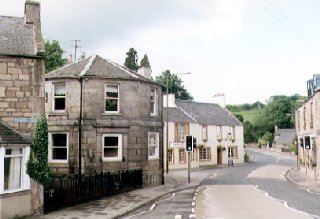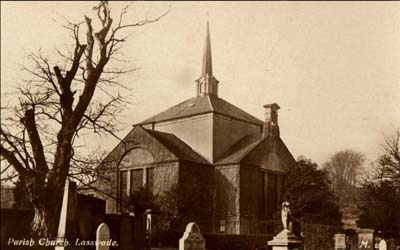Lasswade


The parish church in Lasswade
Lasswade


The parish church in Lasswade
From www.genuki.org: "A small town and parish of Edinburghshire. The town stands on the left bank of the North Esk, but includes the suburb of Westmill in Cockpen parish, with which it is connected by a substantial stone bridge."
"Lasswade parish is bounded N by Colinton, Liberton, and Newton, W by Glencorse, S by Penicuik and Carrington, and E by Cockpen, Newbattle, Dalkeith. Its greatest length, from NNE to SSW, is 7 1/3 miles; its greatest breadth is 6 miles, but its average breadth is little over 3 miles; and its area is 10,678 acres. A projecting wing at the NW extremity is occupied by the E end of the Pentland Hills, presenting partly heath and partly good pasture; and in the S, a district of bleak and unsheltered moorland, including some of the northern declivities of the Moorfoot Hills, stretches for about 2 miles into the interior. The surface on the whole declines rapidly from the border towards the SE, and consists of rich and well-cultivated plain, finely wooded, and of picturesquely diversified scenery."
(Extract from Groomes Ordnance Gazetteer of Scotland c.1895)
From www.bonnyrigglasswadehistory.org.uk:
"A BRIEF HISTORY OF BONNYRIGG & LASSWADE.
The origins of the place names Bonnyrigg and Lasswade are very uncertain, indeed writers over a long period of time have offered their opinions on the matter.
A local author, John.B.Cairns, in his book "Bright and Early", tells us that he found whilst researching material for the book that there were at least twelve different ways to spell Lasswade. The oldest spelling is "Lochswad" from the Celtic language and means a "hollow in the wood". George Chalmers in his work "Caledonia", suggests that the Anglo-Saxon spelling "Laeswe", which means a "common" and the Old English word "weyde" which means a "meadow", are the words from which Lasswade derives its name. In some old documents written in Latin, the place name appears as "Lesswadum vicus", which means village of Lasswade.
Bonnyrigg as a place name is equally as obscure. Early maps of the locality again show different spellings. In 1766 a village called "Bannockrigg", is shown on maps, then in 1815, the spelling changes to "Bannocrig". This spelling remains until 1854, when for some unknown reason the spelling changes to the now familiar Bonnyrigg.
In 1547 when the nations of Scotland and England were at war with one another, a fierce battle took place at Pinkie which is East of Dalkeith and the retreating Scots army with the English army in pursuit, headed westwards to the River North Esk where some 14,000 Scots perished. Many bodies strewed the countryside giving rise to the place being called "boney ridge" where many bones were found, hence the name Bonnyrigg which may be a corruption of these words. Another clue could be the word "bannoc" which means white in the Celtic language, white ridge perhaps?
We know something of the history of Lasswade, from religious sources. In fact the first church in the locality was built in 850 AD. In the 12th century the church and lands of Lasswade were bestowed on the Bishop of St. Andrews. The church of St. Edwin at Lasswade was consecrated in 1240. However by 1565 the church had become Presbyterian (Church of Scotland).
During the early part of the 19th century, industries began to establish
themselves by the River North Esk at Lasswade. In 1828 St. Ann's Distillery
opened on the North bank of the river on land belonging to Lord Melville.
By 1834 the business had closed and the buildings had become a carpet making
factory, employing 100 local people. In 1851 a further 270 workers from
the West of Scotland town of Kilmarnock, were employed at the Lasswade
carpet factory. Over the next six years, carpet making production was estimated
as being 10,000 yards of carpet per day. Demand for quality carpets grew
and eventually a new carpet factory was built in Bonnyrigg in the 1870's.
Carpet making as an industry continued in Bonnyrigg for more than 100 years
and the factory closed in 1978.